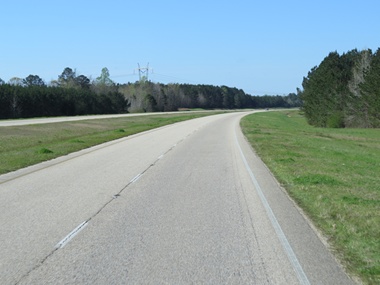
2016-03-23: Less Traveled
As always, if we can use the road less traveled, we do. Route 45 made for an interesting trip and you never know what you're going to encounter...
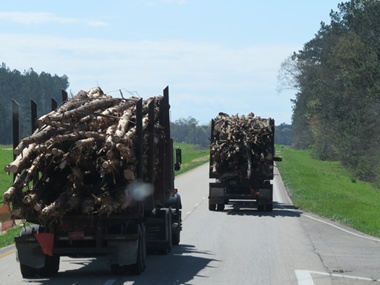
2016-03-23: Log Trucks
...like these log trucks. We see them all the time in Oregon and Washington but somehow didn't expect to see logging in this part of the country. We decided these logs were going to be paper in their next life.
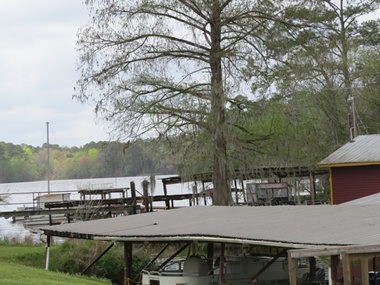
2016-03-23: Lake Talquin
Our site near Quincy, Florida overlooks Lake Talquin and even though it was misty and rainy it was fun watching all the fishermen coming and going. I guess if you fish it doesn't matter if it's wet out!
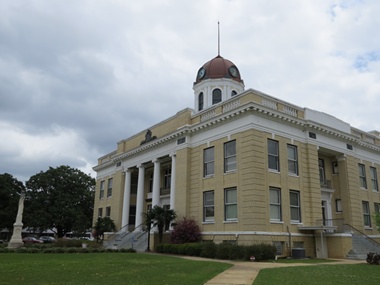
2016-03-24: Quincy
We took a short ride into Quincy, Florida to see their county courthouse. The courthouse square has been used continuously since 1827 as a site for both government and commerce. Settlers began coming to the region soon after the United States acquired the Territory of Florida from Spain in 1821. I spoke to a 92-year old gentleman who has lived here his whole life and he explained that Quincy has been a predominantly agricultural area with tobacco as its most important crop from its early days to the 1970s. The tobacco grown here was used for cigars. Today the main crops are tomatoes, landscape nursery plants and pine trees.

2016-03-24: May House
Driving around town we found many wonderful old homes like this one. As I was taking my picture, the young gal came out and told me that the house was built in 1893 for F.P. May, the local pharmacist, and his wife Anna Stockton. F.P. May, Jr. and wife, Abbie Munroe came to live here after the house was deeded to them upon the death of May, Sr. in 1936. Edwin and Betty May Embry moved here in 1958 and lived in the house until 1982 when someone outside the May family bought it.
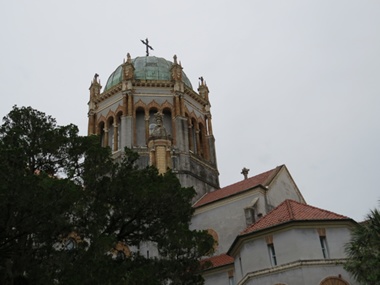
2016-03-25: Memorial Presbyterian Church
The Memorial Presbyterian Church was built in St. Augustine in 1889 by business tycoon and St. Augustine benefactor Henry Morrison Flagler. It was dedicated in honor of his daughter Jennie Louise Benedict, who died following complications from childbirth the same year. Upon Flagler's death in 1913 he was interred in a marble mausoleum within the church beside his daughter Jennie Louise and her infant Marjorie, as well as his first wife Mary Harkness Flagler.
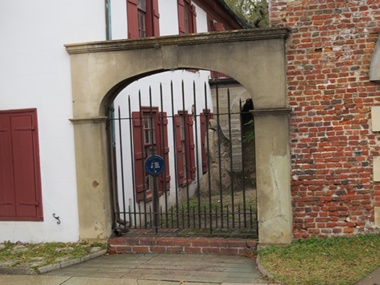
2016-03-25: Cannonball
For about 125 years, the story of the Cannonball House has been part of St. Augustine's lore. Officially, the name of this building is the Jose Tovar House, named for its first documented owner, a Spanish soldier, whose name appeared in association with the building on the 1764 map made by Juan Jose Eligio de la Puente. The tale is that during renovation of the coquina building in the early 1890s two cannonballs were found embedded in the east wall. To make the cannonball more obvious and visible and thus add it to the history of St. Augustine, it was attached to the exterior wall that we see here.

2016-03-25: Coquina Wall
Coquina is a sedimentary rock that is composed either wholly or almost entirely of the transported, abraded, and mechanically-sorted fragments of the shells of mollusks, trilobites, brachiopods, or other invertebrates . The wall was able to absorb the cannonballs without shattering. After dark, soldiers would go out and patch the wall making it look like nothing had hit it thus confusing the enemy. Many of the walls made of coquina here in St Augustine have survived the elements for years.

2016-03-25: Castillo de San Marcos
Castillo de San Marcos, or Fort San Marcos, was built in 1695 by the Spanish colonial government to protect St. Augustine. It followed a series of wooden forts that had been built in response to French and then British pressure on Spain's hold on Florida. It withstood British sieges in 1702 and 1740, but it was turned over to the British after the Seven Years war in trade for Havana, which the British had captured. It was returned to Spain after the American revolution and came under U.S. control in 1821. The fort was built of coquina, which was quarried on nearby Anastasia Island. The Spanish probably used it solely because it was the only material resembling stone on Florida's sandy coast. As it happens, coquina's porosity turned out to be an ideal material for the walls of the fort because cannonballs were absorbed and the walls didn't shatter. Today, at an age of over 300 years, it is North America's oldest masonry fort, junior only to the remains of earthwork Native American structures.
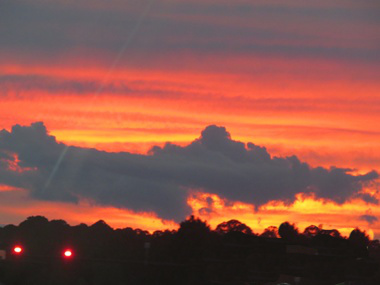
2016-03-25: Sunset
After all the rain and drizzle today, the last thing I expected to see was this beautiful sunset.
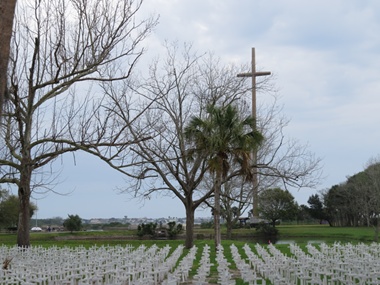
2016-03-26: Tallest Cross
The plaque at the base of the world's tallest cross, which is 208 feet high, says that it "marks the approximate site where in 1565 the cross of Christianity was first permanently planted in what is now the United States." As you walk through the historic grounds, you retrace the steps of America's first founding fathers more than 400 years ago. It was here that Spanish explorers founded our nation's first permanent community and pioneer priests first planted the cross of Christianity. This is the site where western culture and Christian faith took root in our country.
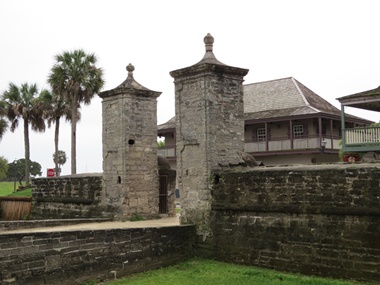
2016-03-26: City Gates
The Old City Gate is a noted landmark in St. Augustine. Constructed of coquina in 1808, it was built at the time of the last reconstruction of the Cubo Line. The gate columns still stand today and reconstructed sections of the earthworks adjoin it to the east and west. The gate opens onto the northern end of St. George Street which leads through the heart of the old city, my favorite part of St. Augustine.
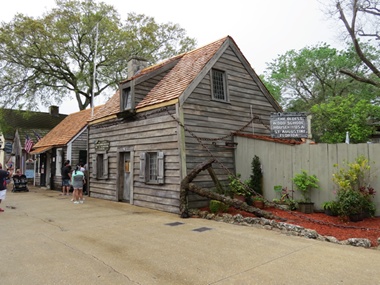
2016-03-26: Old School House
Located near the City Gates, The Old School House is a surviving expression of another time. Although the exact date of construction is unknown, the old wooden schoolhouse is touted as being the oldest wooden school building in the United States. It first appears on tax records in 1716 and was built while Florida was under the rule of Imperial Spain. It was constructed of red cedar and cypress and put together with wooden pegs and handmade nails.
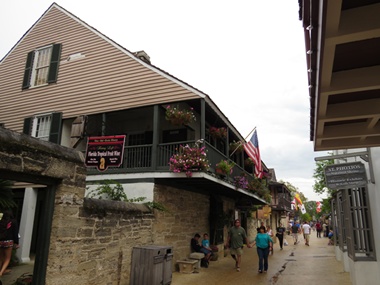
2016-03-26: St George Street
After entering through the city gates you are in historic downtown St. Augustine. Today St. George Street is a pedestrian walkway so you can stroll down the street and take in the history around you. Although the buildings have been updated I could still feel what it must have been like all those years ago.
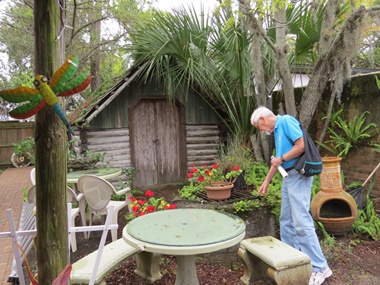
2016-03-26: J.R. Benet
My friend Sally wrote and told me that her great grandmother had lived and had a store on St. George Street many years ago. The front of the building was changed but the shop was named JR Benet Jewelry so I knew I had found the place. They told us we could go out back where we found the old well and an old sign hanging on a wall which read JR Benet. Sally's relatives were Minorcans who came to work on the plantations as slaves and who later escaped and fled to St. Augustine. Their grandson was Stephen Vincent Benet, the poet who wrote John Browns Body among other pieces.
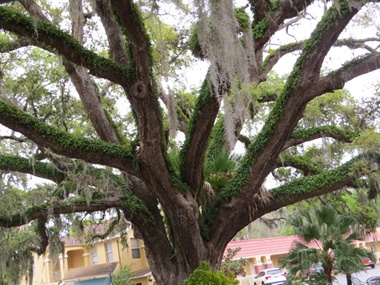
2016-03-26: Love Tree
When two trees are so tightly entwined that they must embrace forever or both die, it is called a love tree. This live oak with a palm growing in it is called The Old Senator and has been core tested to be at least 600 years old! That means that it was alive when Ponce de Leon discovered Florida.
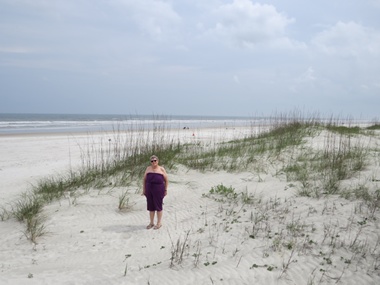
2016-03-27: Beach Day
Today we headed off to Anastasia Island, a barrier island east of St. Augustine. The island is about 14 miles long and about 1 mile in width. The sand here is like talc, white and very soft. What a great place to be.
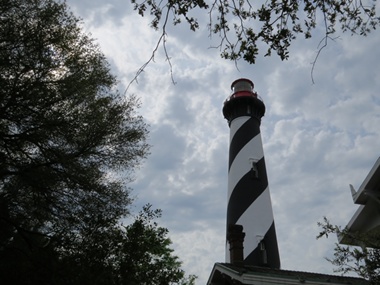
2016-03-27: Lighthouse
Construction on the present lighthouse which replaced several earlier wooden structures began in 1871, and continued for the next three years. Alabama brick and Philadelphia iron work combined with a new hand-blown, nine-foot-tall, Fresnel lens, from Paris, France. This beacon was installed and lit in October of 1874 and remains one of only a few such operating lenses in the United States. The Lighthouse is St. Augustine's oldest surviving brick structure, and today the site is restored to colors and materials used the year 1888. Light keepers' and their assistants lived and worked at the Light Station until the tower was automated in 1955. The St. Augustine Lighthouse rises 165 feet above sea level and contains 219 steps. The original, first order Fresnel lens still serves the beacon, but today is lit by a 1000 watt bulb. The St. Augustine lens consists of 370 hand-cut glass prisms arranged in a beehive shape towering twelve feet tall and six feet in diameter.